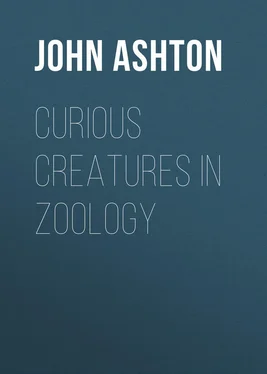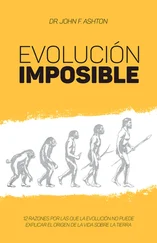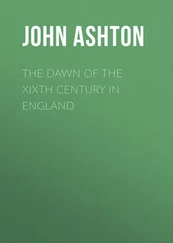John Ashton - Curious Creatures in Zoology
Здесь есть возможность читать онлайн «John Ashton - Curious Creatures in Zoology» — ознакомительный отрывок электронной книги совершенно бесплатно, а после прочтения отрывка купить полную версию. В некоторых случаях можно слушать аудио, скачать через торрент в формате fb2 и присутствует краткое содержание. Жанр: Природа и животные, foreign_antique, foreign_prose, на английском языке. Описание произведения, (предисловие) а так же отзывы посетителей доступны на портале библиотеки ЛибКат.
- Название:Curious Creatures in Zoology
- Автор:
- Жанр:
- Год:неизвестен
- ISBN:нет данных
- Рейтинг книги:4 / 5. Голосов: 1
-
Избранное:Добавить в избранное
- Отзывы:
-
Ваша оценка:
- 80
- 1
- 2
- 3
- 4
- 5
Curious Creatures in Zoology: краткое содержание, описание и аннотация
Предлагаем к чтению аннотацию, описание, краткое содержание или предисловие (зависит от того, что написал сам автор книги «Curious Creatures in Zoology»). Если вы не нашли необходимую информацию о книге — напишите в комментариях, мы постараемся отыскать её.
Curious Creatures in Zoology — читать онлайн ознакомительный отрывок
Ниже представлен текст книги, разбитый по страницам. Система сохранения места последней прочитанной страницы, позволяет с удобством читать онлайн бесплатно книгу «Curious Creatures in Zoology», без необходимости каждый раз заново искать на чём Вы остановились. Поставьте закладку, и сможете в любой момент перейти на страницу, на которой закончили чтение.
Интервал:
Закладка:
John Ashton
Curious Creatures in Zoology
“Travellers see strange things,” more especially when their writing about, or delineation of, them is not put under the microscope of modern scientific examination. Our ancestors were content with what was given them, and being, as a rule, a stay-at-home race, they could not confute the stories they read in books. That age of faith must have had its comforts, for no man could deny the truth of what he was told. But now that modern travel has subdued the globe, and inquisitive strangers have poked their noses into every portion of the world, “the old order changeth, giving place to new,” and, gradually, the old stories are forgotten.
It is to rescue some of them from the oblivion into which they were fast falling, that I have written, or compiled, this book. I say compiled it, for I am fonder of letting old authors tell their stories in their old-fashioned language, than to paraphrase it, and usurp the credit of their writings, as is too much the mode now-a-days.
It is not given to every one to be able to consult the old Naturalists; and, besides, most of them are written in Latin, and to read them through is partly unprofitable work, as they copy so largely one from another. But, for the general reader, selections can be made, and, if assisted by accurate reproductions of the very quaint wood engravings, a book may be produced which, I venture to think, will not prove tiring, even to a superficial reader.
Perhaps the greatest wonders of the creation, and the strangest forms of being, have been met with in the sea; and as people who only occasionally saw them were not draughtsmen, but had to describe the monsters they had seen on their return to land, their effigies came to be exceedingly marvellous, and unlike the originals. The Northern Ocean, especially, was their abode, and, among the Northern nations, tales of Kraken, Sea-Serpents, Whirlpools, Mermen, &c., &c., lingered long after they were received with doubt by other nations; but perhaps the most credulous times were the fourteenth and fifteenth centuries, when no travellers’ tales seem too gross for belief, as can well be seen in the extreme popularity, throughout all Europe, of the “Voyages and Travels of Sir John Maundeville,” who, though he may be a myth, and his so-called writings a compilation, yet that compilation represented the sum of knowledge, both of Geography, and Natural History, of countries not European, that was attainable in the first half of the fourteenth century.
All the old Naturalists copied from one another, and thus compiled their writings. Pliny took from Aristotle, others quote Pliny, and so on; but it was reserved for the age of printing to render their writings available to the many, as well as to represent the creatures they describe by pictures (“the books of the unlearned”), which add so much piquancy to the text.
Mine is not a learned disquisition. It is simply a collection of zoological curiosities, put together to suit the popular taste of to-day, and as such only should it be critically judged.
JOHN ASHTON.CURIOUS CREATURES
Let us commence our researches into curious Zoology with the noblest of created beings, Man; and, if we may believe Darwin, he must have gone through many phases, and gradual mutations, before he arrived at his present proud position of Master and Conqueror of the World.
This philosopher does not assign a high place in the animal creation to proud man’s protogenitor, and we ought almost to feel thankful to him for not going further back. He begins with man as an Ascidian, which is the lowest form of anything of a vertebrate character, with which we are acquainted; and he says thus, in his “Descent of Man”: —
“The most ancient progenitors in the kingdom of the Vertebrata, at which we are able to obtain an obscure glance, apparently consisted of a group of marine animals, resembling the larvæ of existing Ascidians. These animals probably gave rise to a group of fishes, as lowly organised as the lancelet; and from these the Ganoids, and other fishes like the Lepidosiren, must have been developed. From such fish a very small advance would carry us on to the amphibians. We see that birds and reptiles were once intimately connected together; and the Monotremata now, in a slight degree, connect mammals with reptiles. But no one can, at present, say by what line of descent the three higher, and related classes – namely, mammals, birds, and reptiles, were derived from either of the two lower vertebrate classes, namely, amphibians, and fishes. In the class of mammals the steps are not difficult to conceive which led from the ancient Monotremata to the ancient Marsupials; and from these to the early progenitors of the placental mammals. We may thus ascend to the Lemuridæ; and the interval is not wide from these to the Simiadæ. The Simiadæ then branched off into two great stems, the New World, and Old World monkeys; and from the latter, at a remote period, Man, the wonder and glory of the Universe, proceeded.”
“We have thus far endeavoured rudely to trace the genealogy of the Vertebrata, by the aid of their mutual affinities. We will now look to man as he exists; and we shall, I think, be able partially to restore during successive periods, but not in order of time, the structure of our early progenitors. This can be effected by means of the rudiments which man still retains, by the characters which occasionally make their appearance in him through reversion, and by the aid of morphology and embryology. The various facts to which I shall here allude, have been given in the previous chapters. The early progenitors of man were no doubt once covered with hair, both sexes having beards; their ears were pointed and capable of movement; and their bodies were provided with a tail, having the proper muscles. Their limbs and bodies were also acted on by many muscles, which now only occasionally reappear, but are normally present in the Quadrumana… The foot, judging from the great toe in the fœtus, was then prehensile; and our progenitors, no doubt, were arboreal in their habits, frequenting some warm, forest-clad land. The males were provided with great canine teeth, which served them as formidable weapons.”
In fact, as Mortimer Collins satirically, yet amusingly, wrote: —
“There was an Ape, in the days that were earlier;
Centuries passed, and his hair became curlier,
Centuries more gave a thumb to his wrist, —
Then he was Man, and a Positivist.”
Darwin says that the men of the period wore tails, and if they were no longer than that in this illustration (which is copied from the same book), they can hardly be said to be unbecoming – still that is a matter for taste – they are certainly more graceful than if they had been rat-like, or like a greyhound, or toy terrier. Many old authors speak of tailed men in Borneo and Java, and not only were men so adorned, but women. Peter Martyr says that in a region called Inzaganin, there is a tailed race – these laboured under the difficulty of being unable to move them like animals – but as he observes, they were stiff like those of fishes and crocodiles – so much so, that when they wanted to sit down, they had to use seats with holes in them.
Ptolemy and Ctesias speak of them, and Pliny says there were men in Ceylon who had long hairy tails, and were of remarkable swiftness of foot. Marco Polo tells us: “Now you must know that in this kingdom of Lambri 1 1 Supposed to be Sumatra.
there are men with tails; these tails are of a palm in length, and have no hair on them. These people live in the mountains, and are a kind of wild men. Their tails are about the thickness of a dog’s.” Many modern travellers have heard of hairy and tailed people in the Malay Archipelago, and Mr. St. John, writing of Borneo, says that he met with a trader who had seen and felt the tails of a race which inhabited the north-east coast of the island. These tails were about four inches long, and so stiff that they had to use perforated seats. The Chinese also declare that in the mountains above Canton there is a race of tailed men. M. de Couret wrote about the Niam Niams, tailed men, who, he says, are living in Abyssinia or Nubia, having tails at least two inches long. We all know the old Lord Monboddo’s theory that mankind had originally tails – nay, he went further, and said that some were born with them now – a fact which will be partially borne out by any military medical inspecting officer, who in the course of his practice has met with men whose “os coccygis” has been prolonged, so as to form a pseudo tail, which would unfit the man for the cavalry, although he would still be efficient as an infantry soldier.
Интервал:
Закладка:
Похожие книги на «Curious Creatures in Zoology»
Представляем Вашему вниманию похожие книги на «Curious Creatures in Zoology» списком для выбора. Мы отобрали схожую по названию и смыслу литературу в надежде предоставить читателям больше вариантов отыскать новые, интересные, ещё непрочитанные произведения.
Обсуждение, отзывы о книге «Curious Creatures in Zoology» и просто собственные мнения читателей. Оставьте ваши комментарии, напишите, что Вы думаете о произведении, его смысле или главных героях. Укажите что конкретно понравилось, а что нет, и почему Вы так считаете.












